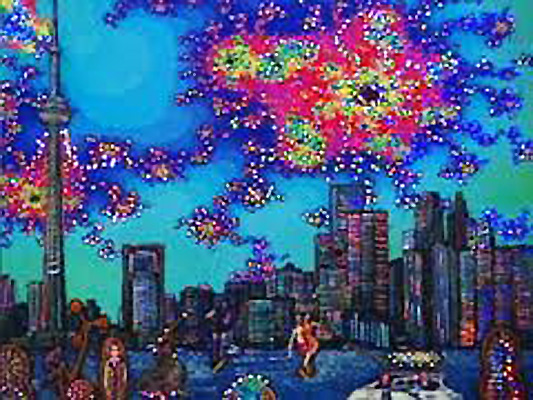 The job of a muse, says Germaine Greer, is to penetrate the male artist and call forth a work from the womb of his mind. She is the anima to his animus, the yin to his yang. When I saw the work of Claude Bolduc from Quebec, I wondered if the same muse spoke to him and Hieronymus Bosch across the span of 500 years.
The job of a muse, says Germaine Greer, is to penetrate the male artist and call forth a work from the womb of his mind. She is the anima to his animus, the yin to his yang. When I saw the work of Claude Bolduc from Quebec, I wondered if the same muse spoke to him and Hieronymus Bosch across the span of 500 years.
Bosch was a respectable, Catholic citizen of a small town in the Netherlands in the mid-15th Century. Sometimes called ‘the devil’s painter’, Bosch’s fantastical imagery portrayed heretical religious narratives; the most memorable are those that depict his nightmarish images of Hell. Bosch’s paintings are instantly recognizable, for it would be impossible to see one without stopping to stare, in trippy wonder, at the abominable events that await us in Hell (as depicted in image above.)
 It’s not that Bolduc’s artwork is heretical. It is not, especially from the perspective of the 21st Century viewer. Rather, his work is Bosch-like because it commands us to stop and consider his proposition from an anything-but-orthodox perspective. I was intrigued when I first encountered Bolduc’s work a few years ago in Quebec, but I had no appreciation for the extent of his work until I met him recently. Bolduc has a long history of creative ventures. Always invested in personal creative expression, he started his career as a composer until life showed him another path – one that he didn’t have to share with others. The decision to pursue art wasn’t so much an epiphany, but rather his lingering memory of the artwork of Arthur Villeneuve, a Québécois painter whom he met as a young man. Although Villeneuve’s early (and private) work was eccentric and unorthodox, he went on to become a well-respected member of the Canadian art establishment. But it was Villeneuve’s early work that inspired Bolduc: unconventional images and an intensely personal means of self-expression. Bolduc describes his own art as ‘art singulier’, a term that describes self-taught artists who are entirely outside the fine art system, either by choice or by circumstance. As Bolduc says, it gives him the right to be himself.
It’s not that Bolduc’s artwork is heretical. It is not, especially from the perspective of the 21st Century viewer. Rather, his work is Bosch-like because it commands us to stop and consider his proposition from an anything-but-orthodox perspective. I was intrigued when I first encountered Bolduc’s work a few years ago in Quebec, but I had no appreciation for the extent of his work until I met him recently. Bolduc has a long history of creative ventures. Always invested in personal creative expression, he started his career as a composer until life showed him another path – one that he didn’t have to share with others. The decision to pursue art wasn’t so much an epiphany, but rather his lingering memory of the artwork of Arthur Villeneuve, a Québécois painter whom he met as a young man. Although Villeneuve’s early (and private) work was eccentric and unorthodox, he went on to become a well-respected member of the Canadian art establishment. But it was Villeneuve’s early work that inspired Bolduc: unconventional images and an intensely personal means of self-expression. Bolduc describes his own art as ‘art singulier’, a term that describes self-taught artists who are entirely outside the fine art system, either by choice or by circumstance. As Bolduc says, it gives him the right to be himself.
The subject of many of Bolduc’s paintings is the skewering of the Church, literally and figuratively. (Above: Coup D’Etat Sur L’Eglise (A Coup on the Church), 1999 – 2000.) It’s not that he has lost his faith; in fact, he is a deeply spiritual person, who believes in the fundamental teachings of the Bible. It is the failings of the Church that trouble him and fuel his prolific art practice. He tends to work in themed series, like the Tarot, The Seven Stations of the Cross, Spirituality, and so on. There is much to show you in next month’s blogs, from early paintings, to drawings, to pastels.















































